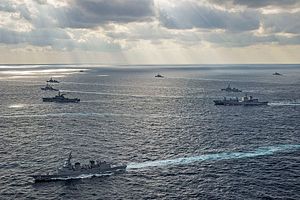Soon, steel-hulled ships will clash in battle. Missiles belching fire will rise quickly from launch tubes, rapidly gathering speed and maneuverability before slamming into enemy vessels at supersonic speeds. Sailors will die, ships will sink, and nations will either rise or fall. Although the time of the battle remains hidden, the site of the battles are known all too well.
Geography is determinate in military plans, a fact that planners understand at all levels, from tactical to strategic. While tailored combat elements may traverse difficult environments on land and at sea, heavily laden logistics craft that follow and enable them can rarely do the same. This is what pushes armies and fleets toward certain immutable routes, resulting in battles occurring at the same locations, over and over, throughout recorded history. Much as the ridge at Megiddo, better known as “Armageddon,” played witness to strife no less than 13 times since the 15th century BCE because it stood astride the route from Mesopotamia to Egypt, key maritime straits such as the waters of the South China Sea and the Sunda and Malaccan Straits will provide the backdrop for future naval battles. Geography and geopolitics are intermeshed and unavoidable. Unfortunately for China, they sit upon the wrong side of the former and are rather poor at the latter. Western advantages in both must not be squandered.
The logic is simple. At sea there are lines of communications that are as well established as interstate highways crossing the United States. Generally speaking, these provide the shortest and most economic routes for ships to travel upon oceans no longer driven by wind and currents as they were in the Age of Sail. However, these same lines invariably pass through extremely constrained nexuses that cannot be avoided, and hence offer moments of critical vulnerability. Almost as much of war is about finding the opponent as it is about acting upon him. When an opponent absolutely must use one of a very limited number of geographically constrained avenues, then there are options. In short, control of chokepoints can determine the course of a conflict. As a result, even in situations short of war, holding these channels essentially secures a nation’s opportunity for wealth and greatness.
The Chinese are rediscovering the facts that their global aspirations place them on the wrong side of geography and thus perpetually behind on the great power “curve,” an observation that sheds light upon much of the military development and geopolitical actions of China over the past generation. For generations they have looked at the island chains that lay off their shores as barriers or maritime “Great Walls” that have effectively shielded them, but only recently have they realized that these islands are trapping them “in” rather than keeping their enemies “out.” Now China is trying to overcome the tyranny of geography (or hydrography as the case may be) through key investments in missiles, ships, aircraft, and port facilities in an attempt to establish control over their near and distant seas.
It is from this vantage point that China’s broad and illegal claims in the South China Sea become understandable as an effort to transform that area into an internal bastion sea. Similarly, while China and its People’s Liberation Army Navy have no ability to control either of the critical Sunda or Malaccan Straits, they are establishing a series of bases that sit astride those straits at places like Hambantota on the southern tip of Sri Lanka and Gwadar in Pakistan, creating the potential for China to deny their enemies access to those channels. A more recent development, the construction of a Chinese base in Djibouti, does much the same for the Red Sea/Suez Canal while simultaneously holding that route as a risk for us.
Such actions, and the poorly played political geostrategic gamesmanship that lies behind them, will inevitably bring China into conflict with the United States and its allies. Fortunately for the United States the sites for these future conflicts are well understood and established, and U.S. long-term investments in long range stealth, directed energy, precision strike, and hypersonic weapons can target the maritime ground zero that these straits represent. China’s strategic miscalculation is that their economy needs access to use the straits, while the United States’ does not.
Strategy involves choices about the vision of war a nation chooses to pursue; one of annihilation, attrition, or exhaustion. Geography, however, remains an unmoving, constraining factor, as the Chinese are re-learning. The United States should seek to develop the doctrines, organizations, and technologies to exploit these ironclad limitations to their aspirations in the most economical manner possible. Sensors, mines, missiles, and unmanned air, surface, and subsurface craft can force China back on the defensive, and shape their spending in the decades ahead while freeing our own resources to focus on other domains.
Dr. Jerry Hendrix is Director of the Defense Strategies and Assessments Program at the Center for a New American Security. Robert Bateman is an International Security Program Fellow at New America.































